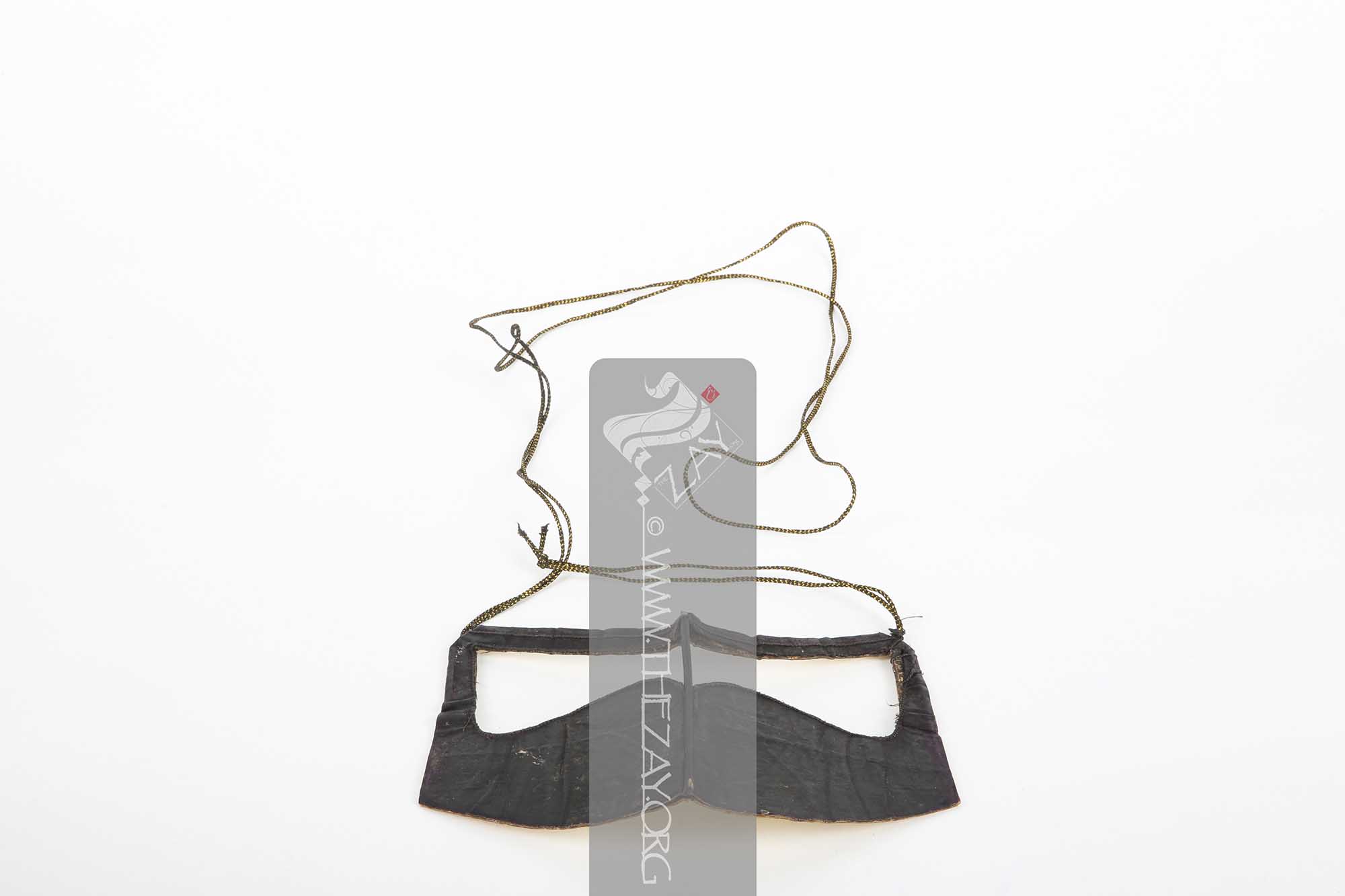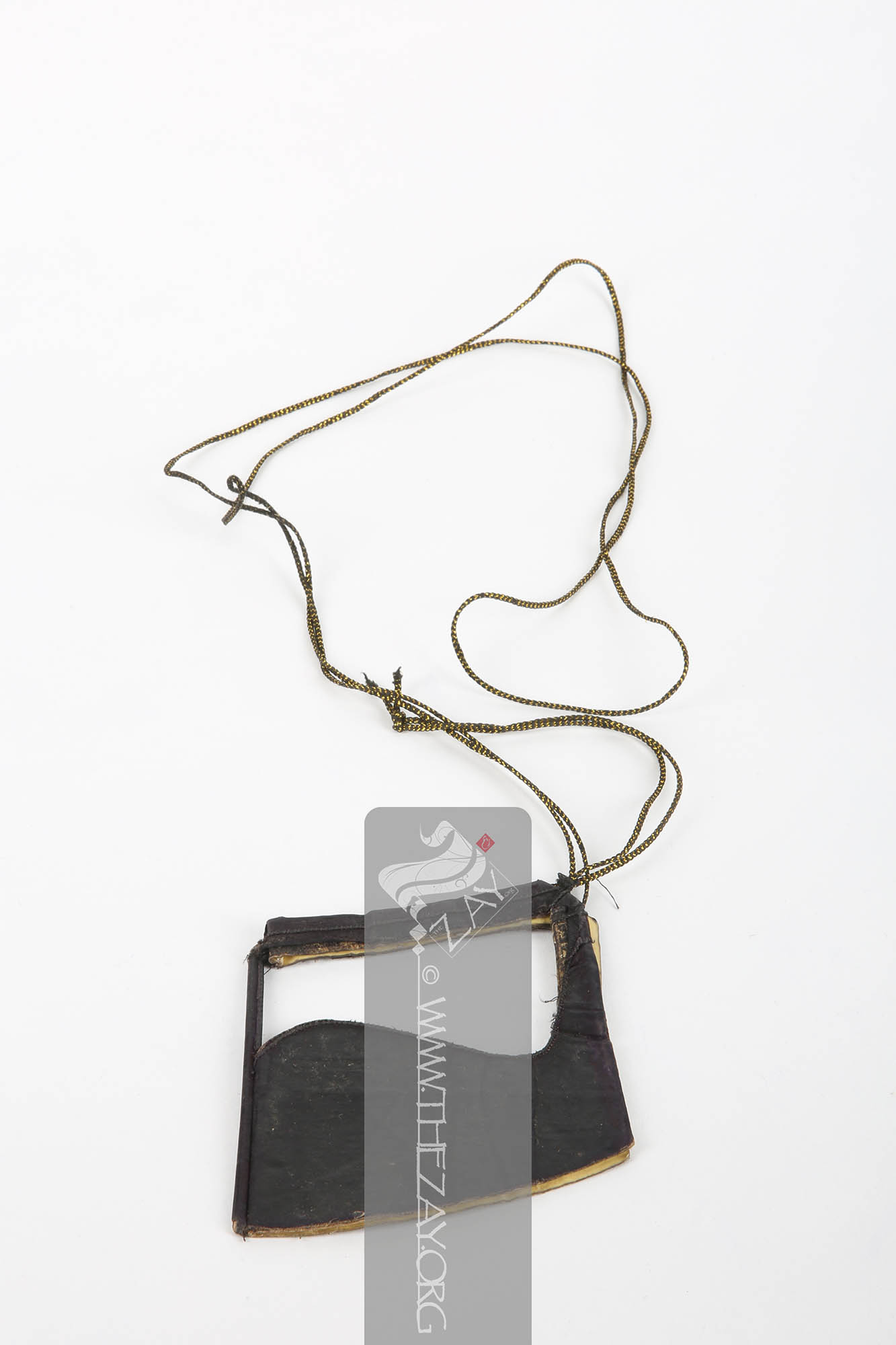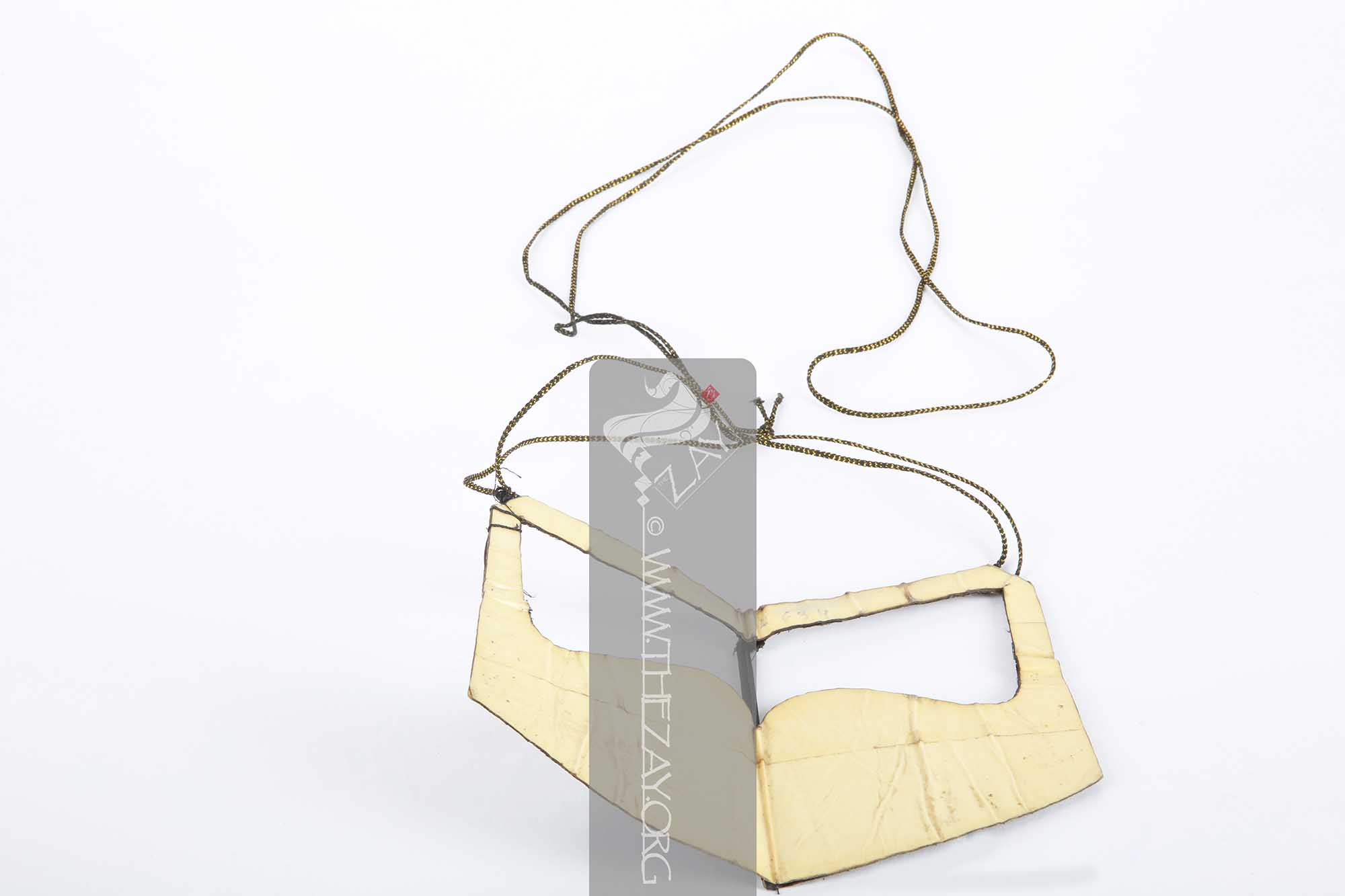Object NotePart of a set of two objects along with another face mask in the collection from the same area of Iran (
ZI2006.500329 ASIA).
Object HistoryThis (burqa) was donated to
Dr. Reem Tariq
Ṭariq: (Arabic; Synonym: tulle_bi_talli
Tūlle_bi_tallī: (French: Tulle – a city in France where fine material for veil was first made; Turkish: tel – wire; Synonym: tariq; talli; badla; khus_dozi ), series of small metal knots made on a woven net ground as embellishment. The term is commonly used in the North African Arab region specifically in Egypt.
; talli; badla; khus_dozi ), series of small metal knots made on a woven net ground as embellishment. The term is commonly used in the Levant Arab region specifically in Lebanon.
El Mutwalli
Dr. Reem Tariq
Ṭariq: (Arabic; Synonym: tulle_bi_talli
Tūlle_bi_tallī: (French: Tulle – a city in France where fine material for veil was first made; Turkish: tel – wire; Synonym: tariq; talli; badla; khus_dozi ), series of small metal knots made on a woven net ground as embellishment. The term is commonly used in the North African Arab region specifically in Egypt.
; talli; badla; khus_dozi ), series of small metal knots made on a woven net ground as embellishment. The term is commonly used in the Levant Arab region specifically in Lebanon.
el Mutwallī: Founder (CEO) of the Zay
Zay: (Arabic: costume, Pl. azyaā’), a set of clothes in a style typical of a particular country or historical period. Initiative, a public figure, speaker and author. An expert curator and consultant in Islamic art and architecture, interior design, historic costume, and UAE heritage. by Khamisa Ismail Matar Hamadi of Maqam, Iran in 2006 to be added to The
Zay
Zay: (Arabic: costume, Pl. azyaā’), a set of clothes in a style typical of a particular country or historical period. Initiative collection to enhance it.
It should be noted that Khamisa is the paternal aunt of Ismail Matar a national athlete – footballer – from the UAE.
Object Features This is an (
indigo
Indigo: (Latin: Indigo – India, synonym: nil
Nīl: (Latin: indigo), Arabised term for Indigo, a natural dye belonging to the ‘Indigofera Tinctoria’ species of plants that have been cultivated in East Asia, Egypt, India, and Peru since antiquity. According to Pliny the Elder, it was named after India as it was the source of the dye.), a natural dye belonging to the ‘Indigofera Tinctoria’ species of plants that has been cultivated in East Asia, Egypt, India, and Peru since antiquity. According to Pliny the Elder, it was named after India as it was the source of the dye. ) dyed stiff cotton burqa with possibly a tinsel cord fastener (
shbuch
Shbūch: (Arabic: shabak: interlace), Colloquially in the UAE term refers to braided cotton or metallic cord used to fasten face mask (burgu’) to the head. The (kāf) turns to (cha) in local dialect.). Made and used in the southern region of Iran, this burqa has a strong resemblance to those used in the countries across the Gulf on the Arabian Peninsula, especially the UAE.
This object resembles other face masks in the collection from the UAE such as (
ZI2021.500903c UAE,
ZI1987.500368 UAE, and
ZI1999.500500 UAE).
Traditionally the design and overall shape (
gardhah
Garḍah: (Arabic: qaraḍa: to bite), in the context of clothing in the UAE it means 'to shape' or 'form'. The (qaf) is pronounced as a (ga) in colloquial Arabic of the Gulf region.) of such a face mask adhere to the aesthetical harmony of the wearer’s facial features accentuating certain characteristics and conversely concealing flaws at the same time. Often newly married young women from the Arabian Peninsula are seen wearing the daintier more revealing versions while the elderly and the widows wear the boxier and more concealing ones.
The masks are often identified by their shape, location, or function. This piece is a typical example of a (
myani
Myānī: (Persian: median), colloquially in the UAE the term refers to a medium proportioned face mask (Burgu).) style, whose overall size and shape are proportionately medium. However, it could also be identified as a burqa (
yasi
Yāsī: (Arabic: name), reference to (Yās) name of prominent UAE tribe, rulers of the Emirate of Abu Dhabi.) after the (
Yas
Yās: (Arabic: name), name of prominent UAE tribe, rulers of the Emirate of Abu Dhabi.) tribe of its distinct cut and shape.
Traditionally in the Arabian Peninsula wearing a burqa symbolises a woman’s coming–of–age and is primarily a social rather than a religious practice and obligation. Since marriage in the past often coincided and was closer to when a woman reached puberty, this practice automatically came to signify a married woman.
With urbanisation and modernisation, the practice of marrying at a younger age eventually became obsolete, thus confining the practice of wearing the burqa to the older generation.
Traditionally these burqas were made from stiff cotton that was imported from India. It was dyed in
indigo
Indigo: (Latin: Indigo – India, synonym: nil
Nīl: (Latin: indigo), Arabised term for Indigo, a natural dye belonging to the ‘Indigofera Tinctoria’ species of plants that have been cultivated in East Asia, Egypt, India, and Peru since antiquity. According to Pliny the Elder, it was named after India as it was the source of the dye.), a natural dye belonging to the ‘Indigofera Tinctoria’ species of plants that has been cultivated in East Asia, Egypt, India, and Peru since antiquity. According to Pliny the Elder, it was named after India as it was the source of the dye. and was available in grades of bluish to purple, which is commonly rubbed and pounded to produce a metallic lustre ranging from yellow to brown to reddish gold which was usually maintained by polishing them with oyster shells. Today, readymade sheets of different lusters are bought commercially, from which a certain number of masks can be cutout.
The
indigo
Indigo: (Latin: Indigo – India, synonym: nil
Nīl: (Latin: indigo), Arabised term for Indigo, a natural dye belonging to the ‘Indigofera Tinctoria’ species of plants that have been cultivated in East Asia, Egypt, India, and Peru since antiquity. According to Pliny the Elder, it was named after India as it was the source of the dye.), a natural dye belonging to the ‘Indigofera Tinctoria’ species of plants that has been cultivated in East Asia, Egypt, India, and Peru since antiquity. According to Pliny the Elder, it was named after India as it was the source of the dye. dye would stain the wearer’s face after repeated wear which made a cloth lining imperative. This lining was usually made from cotton, which was stitched to the underside to prevent stains as well as absorb the oil and perspiration. By the 1980s this trend changed to using strips of masking tape. These were superseded at the turn of the century by clear transparent adhesive sheets, cut to the shape of the burqa.
Although pre–Islamic Persian and Assyrian root of veiling was primarily practiced to distinguish social classes which spread throughout the Arabian Peninsula via trade and interaction, some historians believe that the more recent practice of wearing a face mask, especially in the southern Iranian regions of Hormuz and Bandar Abbas was as recent as c. 16th century with the Portuguese annexation of the port city of Hormuz. According to a BBC article, the “[…] roots of this tradition is unknown although some say that it started during Portuguese rule when women were trying to avoid recognition by slave masters looking for pretty girls.”
Coastal societies in the Arabian Peninsula were influenced by cultures from across the Gulf and beyond, even though most of the Arabian Peninsula remained almost isolated until the 20th century, with tribal customs and traditions shaping their way of life. The development of the oil industry brought rapid changes. This form of veiling thus was initially used to protect women from foreigners and later as a symbol of status which also ties with the practice of dyeing one’s clothes in
indigo
Indigo: (Latin: Indigo – India, synonym: nil
Nīl: (Latin: indigo), Arabised term for Indigo, a natural dye belonging to the ‘Indigofera Tinctoria’ species of plants that have been cultivated in East Asia, Egypt, India, and Peru since antiquity. According to Pliny the Elder, it was named after India as it was the source of the dye.), a natural dye belonging to the ‘Indigofera Tinctoria’ species of plants that has been cultivated in East Asia, Egypt, India, and Peru since antiquity. According to Pliny the Elder, it was named after India as it was the source of the dye. .
This form of veiling thus was initially used to protect women from foreigners and later as a symbol of status which also ties with the practice of dyeing one’s clothes in
indigo
Indigo: (Latin: Indigo – India, synonym: nil
Nīl: (Latin: indigo), Arabised term for Indigo, a natural dye belonging to the ‘Indigofera Tinctoria’ species of plants that have been cultivated in East Asia, Egypt, India, and Peru since antiquity. According to Pliny the Elder, it was named after India as it was the source of the dye.), a natural dye belonging to the ‘Indigofera Tinctoria’ species of plants that has been cultivated in East Asia, Egypt, India, and Peru since antiquity. According to Pliny the Elder, it was named after India as it was the source of the dye. . As a plant believed to be originally native to India
indigo
Indigo: (Latin: Indigo – India, synonym: nil
Nīl: (Latin: indigo), Arabised term for Indigo, a natural dye belonging to the ‘Indigofera Tinctoria’ species of plants that have been cultivated in East Asia, Egypt, India, and Peru since antiquity. According to Pliny the Elder, it was named after India as it was the source of the dye.), a natural dye belonging to the ‘Indigofera Tinctoria’ species of plants that has been cultivated in East Asia, Egypt, India, and Peru since antiquity. According to Pliny the Elder, it was named after India as it was the source of the dye. had been cultivated over centuries in Egypt, South America, and the Far East. It was traditionally imported and was considered a prized product that could only be afforded by the rich and the affluent. Gradually over centuries and with the rise of globalisation this tradition became a part of national and ethnic identity around the region.
Links
- El Mutwalli, Reem Tariq. Sultani
Sulṭānī: (Arabic: sultān: king). In the UAE the term denotes to silk satin fabric in multiple vertical striped colours, commonly used for tunics (kanadir) and underpants (sarāwīl). Also refers to book: Sultani, Traditions Renewed, Changes in women’s traditional dress In the United Arab Emirates during the reign of the late Shaykh Zāyid Bin Sultan āl Nahyān, 1966-2004, By Dr. Reem Tariq
Ṭariq: (Arabic; Synonym: tulle_bi_talli
Tūlle_bi_tallī: (French: Tulle – a city in France where fine material for veil was first made; Turkish: tel – wire; Synonym: tariq; talli; badla; khus_dozi ), series of small metal knots made on a woven net ground as embellishment. The term is commonly used in the North African Arab region specifically in Egypt.
; talli; badla; khus_dozi ), series of small metal knots made on a woven net ground as embellishment. The term is commonly used in the Levant Arab region specifically in Lebanon.
El Mutwalli (2011).: Traditions Renewed. Changes in Women’s Traditional Dress in the United Arab Emirates During the Reign of the Late Shaykh Zâyid Bin Sultan Âl Nahyân, 1966-2004. 2011.
- https://thezay.org/shop/sultani
Sulṭānī: (Arabic: sultān: king). In the UAE the term denotes to silk satin fabric in multiple vertical striped colours, commonly used for tunics (kanadir) and underpants (sarāwīl). Also refers to book: Sultani, Traditions Renewed, Changes in women’s traditional dress In the United Arab Emirates during the reign of the late Shaykh Zāyid Bin Sultan āl Nahyān, 1966-2004, By Dr. Reem Tariq
Ṭariq: (Arabic; Synonym: tulle_bi_talli
Tūlle_bi_tallī: (French: Tulle – a city in France where fine material for veil was first made; Turkish: tel – wire; Synonym: tariq; talli; badla; khus_dozi ), series of small metal knots made on a woven net ground as embellishment. The term is commonly used in the North African Arab region specifically in Egypt.
; talli; badla; khus_dozi ), series of small metal knots made on a woven net ground as embellishment. The term is commonly used in the Levant Arab region specifically in Lebanon.
El Mutwalli (2011).-traditions-renewed/
- BBC Article: https://www.bbc.com/travel/article/20170106-the-mysterious-masked-women-of-iran
- https://www.ccpl.org/charleston-time-machine/indigo
Indigo: (Latin: Indigo – India, synonym: nil
Nīl: (Latin: indigo), Arabised term for Indigo, a natural dye belonging to the ‘Indigofera Tinctoria’ species of plants that have been cultivated in East Asia, Egypt, India, and Peru since antiquity. According to Pliny the Elder, it was named after India as it was the source of the dye.), a natural dye belonging to the ‘Indigofera Tinctoria’ species of plants that has been cultivated in East Asia, Egypt, India, and Peru since antiquity. According to Pliny the Elder, it was named after India as it was the source of the dye. -fabric-early-south-carolina
- https://www.aljazeera.com/features/2020/12/13/indigo
Indigo: (Latin: Indigo – India, synonym: nil
Nīl: (Latin: indigo), Arabised term for Indigo, a natural dye belonging to the ‘Indigofera Tinctoria’ species of plants that have been cultivated in East Asia, Egypt, India, and Peru since antiquity. According to Pliny the Elder, it was named after India as it was the source of the dye.), a natural dye belonging to the ‘Indigofera Tinctoria’ species of plants that has been cultivated in East Asia, Egypt, India, and Peru since antiquity. According to Pliny the Elder, it was named after India as it was the source of the dye. -and-the-story-of-indias-blue-gold
- https://www.npr.org/2011/11/07/142094103/indigo
Indigo: (Latin: Indigo – India, synonym: nil
Nīl: (Latin: indigo), Arabised term for Indigo, a natural dye belonging to the ‘Indigofera Tinctoria’ species of plants that have been cultivated in East Asia, Egypt, India, and Peru since antiquity. According to Pliny the Elder, it was named after India as it was the source of the dye.), a natural dye belonging to the ‘Indigofera Tinctoria’ species of plants that has been cultivated in East Asia, Egypt, India, and Peru since antiquity. According to Pliny the Elder, it was named after India as it was the source of the dye. -the-indelible-color-that-ruled-the-world






